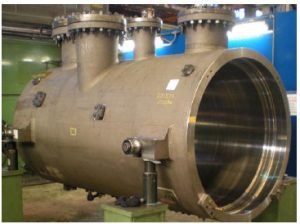Barrel vs integrally geared compressor for CO2 project
CO2 injection is being incorporated into the Gorgon Project to reduce overall greenhouse gas emissions. CO2 will be injected into an underground reservoir at a depth of approximately 8202 feet (2500 m) and a pressure close to 2900 psi (200 bar). During the equipment selection process for CO2 compression, conventional barrel type compressors were chosen over integrally geared equipment.
Below are excerpts from “CO2 compression at world’s largest carbon dioxide injection project” by Antonio Musardo, Gabriele Giovani, Marco Pelella and Sergio Cipriani of GE Oil & Gas Florence, Italy, Vinod Patel of KBR Houston, Texas, and Mark Weatherwax of Chevron ETC Houston, Texas, at the 2013 Middle East Turbomachinery Symposium.

LP compressor[/caption]
The two types of compressors found to be applicable for this service were conventional beam type compressors and integrally geared compressors. The following considerations were made in determining the final selection. • Safety aspects with CO2 and H2S, specifically with regard to the available sealing technologies. • Maintainability and maintenance access (ergonomics). • Machine complexity. • Intercoolers using air coolers instead of water coolers. • Nozzle loads with cyclonic wind conditions. • Overall power consumption for CO2 injection.
At the time of the compressor technology reviews, the integrally geared compressors used in comparable high pressure services utilized carbon ring seals. The carbon rings seals are referenced back to lower pressure stages to prevent leakage. During a shutdown, the casings will reach the same settle-out pressure, and the seals will leak to the atmosphere unless the unit is depressurized. Fast depressurization is a concern for CO2 because of the formation of solid CO2 (dry ice). Considering the compressors were being located in modules and the process gas contains minor amounts of H2S, it was determined that DGS were required for the application for safety considerations.
The conventional beam type compressor arrangement consists of two compressor bodies and therefore 4 DGS. The integrally geared option requires a minimum of 8 compressor stages and therefore 8 DGS. Ergonomic design is an important Gorgon Project goal for the plant operators and maintenance personnel. This will improve the safety aspects for maintenance/operation and enhance the overall plant operability and reliability. The conventional beam type compressor can be designed to improve access to bearings, seals and rotating assemblies. The barrel type compressor arrangement selected does not require the process piping to be removed for normal maintenance activities. Integrally geared compressors require removal of suction piping, head covers and impellers to access DGS, and removal of discharge piping, stage casing and upper half of the gear box casing to access journal bearings.
From a safety standpoint, the HP barrel compressor has been designed with only one head-cover (3rd suction side) while the 4th stage head-cover is integral with casing and avoids the risk of high pressure leakage. The integrally geared option needs head-covers with relevant sealing gaskets on all 8 stages. The class of CO2 compressors used for this application are complex regardless of the type of compressor chosen. The barrel compressors are each located on opposite ends of a double ended VFD.
CO2 string configurationBoth compressors utilize a speed increasing gear between the compressor body and the motor. This arrangement, utilizing a VFD, results in complex torsional and lateral interactions that will be discussed further in this paper. Similarly, 8 stage integrally geared compressors are complex mechanical assemblies with 4 pinion gears and variable inlet guide vanes on multiple compressor stages. For the Gorgon facility, the stage inter-cooling is performed with air coolers. With the conventional (barrel) machine design there are 4 compression stages utilizing 3 intercoolers and one after-cooler. These coolers are located on the top level of the modules.
When integrally geared compressors are considered, more inter-coolers are utilized to fully achieve the increased efficiency and reduced compression power. Integrally geared compressors lend themselves to water cooled facilities so the inter-stage piping and associated pressure drops can be minimized by locating the inter-coolers very close to the compressor.
For the Gorgon Project, the use of water cooling was not an option, and therefore, the increased pressure drop between stages for air coolers and piping diminishes the overall efficiency gains from the integrally geared option.
The Gorgon Project facility on Barrow Island is located off the coast of Northwest Australia in an area prone to tropical cyclones. As such, the facility is designed to withstand cyclonic wind loads and operate through major storm events. The barrel types compressor casings are more suitable to withstand the large nozzle loads that result.
The design basis for the compressors is to handle up to 20 times the NEMA flange loads. Integrally geared compressors with the scroll connected to the gear casing do not lend themselves to the same levels of flange loading. The overall efficiency is higher for the integrally geared options resulting in lower compression power.
This improved efficiency results from the ability to optimize each pinion speed for maximum stage efficiency and utilize more stages of intercooling. The requirement for air cooling and the location of the inter-coolers increased the inter-stage pressure losses.
The increased inter-stage pressure loss minimizes the overall efficiency improvements between the two options. In addition, at the time the compressor type selections were made, integrally geared compressors were not referenced for a combination of the flows and discharge pressures required for the Gorgon CO2 injection application. The final result of the review was to select the barrel type compressor primarily due to the ability to minimize the number of seals, improve the maintenance access and to accommodate the cyclonic wind conditions that would be experienced at site.